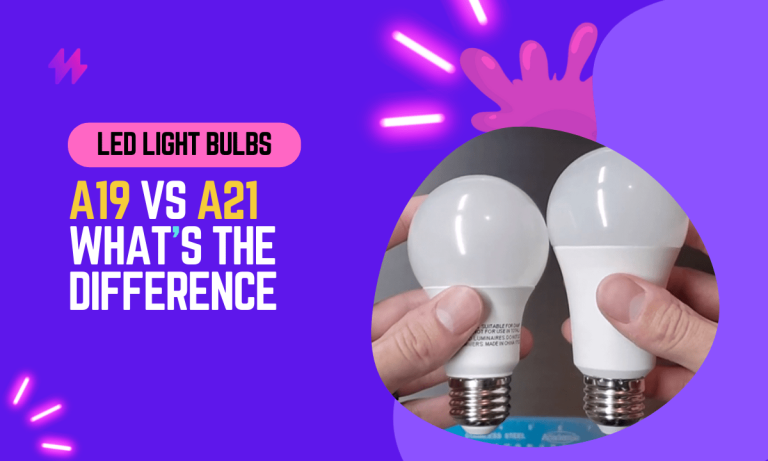Do You Put LED Lights On The Ceiling Or Wall?

In recent years, LED lights have become a popular choice for lighting in both homes and businesses. LED lights have several advantages over other types of lighting, including lower energy consumption, longer life spans, and cooler operating temperatures. LED lights are available in various colors and width sizes and can be used for various purposes.
Two main ways to install LED lights are on the ceiling or the wall. Both options have pros and cons, so it is important to consider all the factors before making a final decision.
When considering the placement of LED lights, you might wonder, “do you put LED lights on the ceiling or wall?” Both suspended ceilings and false ceilings can effectively accommodate downlights and strip lighting, creating powerful task light options for various interior spaces.
LED Lighting Placement: Is the Ceiling or Wall Your Best Option?
LED lights can go either way; both have pros and cons for lighting on walls & ceilings. So first, you need to decide the location and purpose of installing the LED lights.
LED lights can be strategically placed to create both ambiance and functionality, enhancing the interior design of your house. Choosing the right electrical connectors and ensuring proper soldering of wires will help support the installation of your LED light source effectively, whether you aim for a continuous light-bar effect or opt for a sleek led tape range along the perimeter.
Do You Put LED Lights on the Ceiling or Wall? Choosing the Right Location
Ceiling LED lights can illuminate a room without taking up too much space. LED ceiling lights are often used in living rooms, bedrooms, and hallways, where the light must be spread evenly throughout the space. LED lights on the ceiling can also provide a more focused light source for tasks such as reading or studying. LED ceiling lights are usually installed in recessed fixtures, which helps to reduce the amount of glare and provides a more uniform light output.
On the other hand, LED wall lights provide more direct lighting for specific tasks or areas. LED wall lights are often used as accent lighting to highlight a room’s artwork, sculptures, or other features. LED wall lights can also provide more focused task lighting in office or work areas and are often used to illuminate cabinets, shelves, closets, and other storage areas. LED wall lights are generally installed on a surface such as a wall or ceiling and direct the light downward onto the desired area.
When deciding between LED ceiling lights and LED wall lights, it is important to consider the size of the space, the type of light needed, and the overall aesthetic desired. LED lights are a great way to add style and ambiance to any room, so choosing a solution that will work best for your needs is important.
Incorporating LED lights as a light-source can transform the feel of any room when placed strategically. Whether utilizing LED tape light along the perimeter or installing fixtures in a drop-down ceiling, the right choice enhances both functionality and visual appeal, becoming a central feature of your interior design and showcasing the reflective floor tiles below.
Advantages of Installing LED Strip Lights on the Wall: A Comprehensive Guide

There are several benefits of sticking LED lights on the wall.
Utilizing LED lights on the wall can optimize the use of electricity while enhancing the visual aesthetics of your space. This installation allows for creative feature-light effects that draw attention to specific areas, particularly when aiming light upwards to draw the gaze towards the main ceiling or other architectural elements.
Enhanced Lighting Solutions: Can Provide Task or Accent Lighting
LED wall lights are ideal for task or accent lighting in specific areas. LED wall lights can illuminate a room’s artwork, sculptures, cabinets, shelves, and other features. LED wall lights also provide more direct light than LED ceiling lights, making them perfect for focused tasks such as reading or studying.
When choosing between LED lights on the wall versus those installed in a ceiling structure, it’s important to consider how each will illuminate the room. For instance, LED wall lights can provide a wide beam of light that focuses on the front and center of your artwork, making those features stand out without creating a dim atmosphere that undermines the overall design.
Positioning LED Lights: It Can Be Easily Positioned
LED wall lights are easy to adjust and move around as needed. This makes them ideal for areas where you may need to frequently adjust the position of the light, such as in an office or work area—allowing you to direct the light exactly where it is needed.
Moreover, the flexibility of LED wall lights ensures they can easily be repositioned to focus on different areas, such as artwork or workspaces, improving their effectiveness. When used alongside drop-down ceilings, these lights can create a cohesive layout that enhances the overall sight and functionality of the room.
Highlighting Wall Art or Decorative Elements with LED Lights: Choosing the Best Location
LED wall lights provide a more focused light source that can draw attention to specific design elements, making the entire space look more visually appealing. LED wall lights also highlight a room’s artwork, sculptures, and other features.
The strategic placement of LED wall lights allows for unique facing directions that highlight various aspects of the room’s design. By positioning them thoughtfully, you can ensure that the light guides the viewer’s eye toward architectural features or decorative pieces, establishing an inviting atmosphere.
Disadvantages of Installing LED Strip Lights on the Wall
Low Brightness: Understanding the Drawbacks of Wall-Mounted LED Strip Lights
They are typically not as bright as LED ceiling fixtures, so better options for areas needing higher lighting may exist.
When assessing the lighting needs of a space, you might find that LED ceiling fixtures are more suitable for achieving greater brightness compared to LED wall lights. It’s essential to evaluate the specific requirements of each area, as LED ceiling options might provide the intense illumination necessary for tasks or larger rooms.
Advantages of Installing LED Strip Lights on the Ceiling: A Comprehensive Guide

Installing LED strip lights on the ceiling can provide plenty of illumination, making them great for large areas or workspaces. LED lighting on the ceiling is less likely to cast glare and shadows than on the wall, so it’s ideal for maintaining a consistent, even light.
Some of the pros of having LED lights on the ceiling are:
One advantage to consider is that LED strip lights can be easily integrated into various ceiling designs, enhancing the aesthetic appeal of a room while providing efficient lighting. Additionally, the use of LED lighting in a ceiling installation can complement other fixtures, creating a harmonious balance of brightness and style throughout your space.
Creating a More Spacious Feeling with LED Strip Lights on the Ceiling
LED ceiling lights can provide a more spacious feeling by creating an even ambient light that fills the entire room. LED lights on the ceiling also help to reduce shadows, giving the illusion of more space.
LED lights on the wall can bring a touch of creativity to your decor, allowing you to highlight unique features and enhance the room’s visual dynamics. By thoughtfully incorporating both LED ceiling and wall lights, you can achieve a well-rounded lighting design that promotes both functionality and aesthetic appeal.
Positioning LED Lights: It Can Be Easily Positioned
LED ceiling lights are easy to adjust and move around as needed. This makes them ideal for areas where you may need to frequently adjust the position of the light, such as in a living room or bedroom. LED ceiling lights are also easy to install and can be mounted directly onto the ceiling with minimal effort.
The versatility of LED lights allows for seamless integration into various spaces, making them ideal for dynamic environments. By choosing the right placement of LED lighting, you can enhance both the comfort and style of your living spaces.
Ambient Lighting Benefits of LED Strip Lights: Ceiling vs. Wall Placement
LED ceiling lights are perfect for providing a soft, ambient light that fills the entire room.
In addition to their effective illumination, LED ceiling lights contribute to energy efficiency, making them a practical choice for eco-conscious homeowners. By incorporating these versatile fixtures into your overall lighting design, you can create a harmonious balance between form and function in your interior spaces.
Highlighting Architectural Features with LED Strip Lights: A Guide
LED ceiling lights can also highlight architectural features such as beams, arches, and other decorative elements in a room. LED ceiling lights provide a more focused light source that can help draw attention to specific design elements.
In addition to their role in emphasizing architectural features, LED ceiling lights can greatly improve the overall brightness of a room, making it more inviting. Effective placement of LED lights on the ceiling creates a dramatic effect that can elevate your interior design while also ensuring optimal functionality throughout your space.
Cons of Mounting LED Strip Lights on the Ceiling: Understanding the Drawbacks
LED strip lights on the ceiling can be tricky to install, as you may need to make holes in the wall or ceiling for wiring and mounting.
When dealing with LED lights on the ceiling, it’s essential to take careful measurements to ensure that the installation is both functional and visually appealing. Proper installation techniques will guarantee that your LED strip lights create the desired effect without compromising the integrity of your walls or ceilings.
May Not Look Good if You Have Low Ceilings: Understanding the Placement of LED Lights
LED strip lights on the ceiling may not look good in rooms with low ceilings, as the LED strip lights are quite large and bulky.
Consideration of low ceiling spaces is crucial when choosing LED strip lights, as their bulkiness might detract from the room’s aesthetics. Therefore, opting for slimmer LED fixtures can provide a more suitable lighting solution that enhances both the visual appeal and functionality of the area.
Less Flexibility Compared to LED Wall Lights: A Comprehensive Look
Although LED strip lights on the ceiling can provide plenty of illumination for a room, they are less adjustable or flexible than LED wall lights. You may be unable to move LED strip lights on the ceiling when needed, so LED wall lights may be a better option if you want more control over your lighting.
Choosing between LED lights on the ceiling and those on the wall can significantly affect the ambiance of your space. For enhanced control and adaptability in lighting design, LED wall lights offer a versatile solution compared to fixed ceiling lights.
Final Thoughts on LED Lighting Placement: Ceiling vs. Wall
When choosing LED lights, it is important to consider the size of the space, the type of light needed and the overall aesthetic desired. LED ceiling lights and LED wall lights offer unique benefits that can help create a more inviting atmosphere in any room. LED ceiling lights are great for soft ambient lighting, while LED wall lights provide task or accent lighting, making them perfect for highlighting artwork and other decorative elements. LED lights are a great way to add style and ambiance to any space.
In conclusion, the decision on whether to install LED lights on the ceiling or the wall hinges significantly on both the functional needs and aesthetic preferences of the space being illuminated. Ceiling-mounted LED lights are typically used to provide general lighting across an entire room. This placement allows for a wide distribution of light, making it ideal for primary light sources in living rooms, kitchens, and bedrooms. The elevation of the ceiling placement helps avoid direct glare, making it comfortable for everyday activities, and it can make rooms feel larger and more open.
Alternatively, wall-mounted LED lights offer more specialized lighting solutions that can enhance the ambiance or highlight specific features of a room. For instance, wall-mounted LEDs are perfect for creating accent lighting, which can draw attention to artwork, bookshelves, or architectural details. They can also provide excellent task lighting in spaces like bathrooms and kitchens, where work needs to be performed at close quarters. Furthermore, the choice between wall and ceiling installation might depend on the existing decor and the desired dramatic effect. Wall lights can add layers to a room’s lighting scheme, creating a warm and inviting atmosphere with shadows and highlights, whereas ceiling lights provide uniformity and functionality. Ultimately, the best approach often involves a combination of both, allowing the strengths of each placement to complement the other, thereby creating a well-rounded and effective lighting environment.
Do You Put LED Lights On The Ceiling Or Wall | LED Lighting Placement Considerations
Considering where to place LED lights involves understanding the specific needs of your space. The question “Do You Put LED Lights On The Ceiling Or Wall” often arises as individuals seek to optimize both aesthetics and functionality. Assessing room height and size plays a vital role in this decision. Taller ceilings might benefit from ceiling-mounted fixtures, creating a more spacious feel, while wall-mounted options can enhance intimacy in smaller areas. Ultimately, the answers to “Do You Put LED Lights On The Ceiling Or Wall” hinge on how best to balance natural light, desired ambiance, and the specific activities that will take place in the room.
Do You Put LED Lights On The Ceiling Or Wall | Assessing Room Height and Size
Assessing room height and size is crucial when determining whether to install LED lights on the ceiling or wall. High ceilings may benefit from ceiling-mounted lights, which can create an open and airy atmosphere. On the other hand, smaller rooms may feel cozier and more inviting with wall-mounted LED solutions that draw the eye downward, providing a sense of intimacy. Understanding the dimensions of the space helps inform the best placement for optimal lighting effects.
Consider how the size and height of a room will influence the overall lighting scheme. Do you put LED lights on the ceiling or wall entirely depends on the functionality desired. For instance, wall lights can enhance decorative elements or artwork, while ceiling lights typically provide broader illumination. Evaluating these factors will ensure that the lighting complements the room’s design and usability, creating the desired ambiance for any space.
Evaluating Functionality and Purpose
Determining the purpose of your LED lighting can significantly influence your choice between ceiling and wall placement. If the primary goal is to illuminate a large area, ceiling-mounted lights typically provide broader coverage and a more even distribution of light. On the other hand, wall-mounted LEDs can create targeted lighting, perfect for highlighting artwork, accentuating architectural features, or providing task lighting in specific zones. Understanding how you plan to use the space is crucial in deciding, “Do you put LED lights on the ceiling or wall?”
The ambiance you wish to achieve also plays a critical role in lighting placement. For example, if a cozy atmosphere is desired, wall lights can cast softer shadows and create an inviting feel. Ceiling lights, especially recessed options, tend to create a more modern look but can sometimes feel stark or clinical. Identifying the mood you want to set helps answer the question, “Do you put LED lights on the ceiling or wall?”






